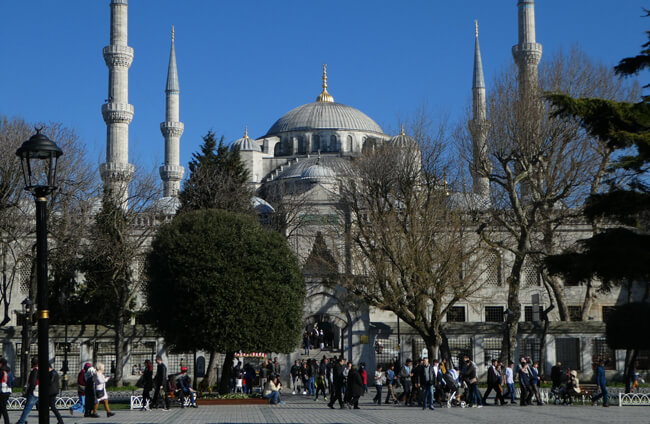-

 Know, the true nature of your Beloved.
Know, the true nature of your Beloved.
In His loving eyes, your every thought,
Word and movement is always –
Always Beautiful.
~ Hafiz
Sacred Architecture

Suleymaniye Mosque
The Suleymaniye Mosque, completed during the ‘Golden Age’ of the Ottoman Empire, was dedicated to Suleyman the Magnificent, the longest serving and greatest of the Ottoman sultans. At the helm of this vast empire, Suleyman instituted major judicial and social changes by harmonizing sultanic and religious law. He was also a great patron of culture which resulted in an artistic, literary and architectural flowering throughout the empire.
Suleyman’s architect, Sinan (1539 – 1588), left an imprint of genius over the empire, ensuring that he became one of the world’s most celebrated architects. He designed a large number of buildings that helped to create the renowned urban image of Istanbul – particularly mosques with seemingly weightless, light-filled centralized domes that have been compared with developments in Renaissance Italy.
Commenced in 1550, under Sinan’s supervision, the Suleymaniye complex is the largest socio-religious group of buildings from the Ottoman Empire. A large courtyard around the mosque provides a tree filled barrier between it and the other buildings of the complex, that included a Koran school, four madrasas (that provided different levels of Islamic education), a large hospital, medical school, public kitchen, hospice, caravanserai (accommodation for travellers) and public baths. On a lower level, there was a hadith school and more accommodation. Shops were also incorporated into the complex. Consequently, the Suleymaniye complex became one of the centres of religious and cultural life in Istanbul.
Sinan sculpted the Suleymaniye in three dimensions to produce its mountainlike pyramidal silhouette. By reshaping the sloping terrain of the site with terracing and retaining walls, the centrally located mosque seems to grow organically from the third hill of the city, visually dominating the surrounding complex and the overall cityscape. Integrated aspects, such as not to obstruct the exquisite view of the Golden Horn from the eastern esplanade were achieved by adjusting the height of the associated stepped twin madrasas. Its four slender minarets are skilfully integrated into the four corners of the marble paved forecourt, accentuating the pyramidal mass of the Suleymaniye by varying the size of each matching pair of minarets.
The Suleymaniye mosque is crowned by a central dome flanked by two half domes and although more sophisticated in its structure, detail and outcome, it is similar to the Hagia Sophia mosque. Sinan integrated the structural buttress system into the articulation of the interior space by a clever composition of inner and outer galleries at ground level. Light floods into the mosque from every level through 249 windows, evoking a sense of an enclosed paradise, reinforced by references to Paradise in the calligraphy of the superb iznik tile decoration.
An average of 3,000 men worked daily on the construction. It’s construction and on-going upkeep was funded by both the Ottoman sultans and private bequests.
A point of interest is that the royal women were equally as active in philanthropy as the men. Suleyman’s mother endowed a large mosque complex in Manisa and his daughter sponsored two complexes in Istanbul. His wife commissioned major trusts in Mecca, Medina, Jerusalem, Istanbul and Edirne, that resulted in the establishment of important buildings and social programs.
Sources:- “The Age of Sinan, Architectural Culture in the Ottoman Empire” by Gulru Necipoglu.
“Ottoman Civilization” edited by Halil Inalcik and Gunsel Renda for the Republic of Turkey Ministry of Culture and Tourism.
“A History of the Ottoman Empire” by Douglas A. Howard.
